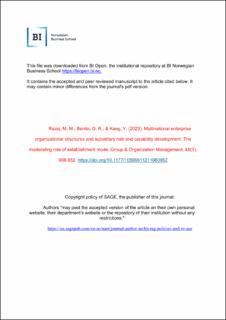Multinational enterprise organizational structures and subsidiary role and capability development: The moderating role of establishment mode
Peer reviewed, Journal article
Accepted version
Permanent lenke
https://hdl.handle.net/11250/3091674Utgivelsesdato
2021Metadata
Vis full innførselSamlinger
- Scientific articles [2181]
Sammendrag
Multinational enterprises (MNEs) develop structural configurations for managing their geographically dispersed and disaggregated activities. These structures can be classified as (a) simple headquarters configurations (involves corporate, regional, divisional headquarters and mandated units) involving few direct reporting relationships; (b) network organizations involving no direct reporting relationships; and (c) matrix configurations involving multiple reporting relationships. While these structures are built for handling various complexities and purposes, it is unclear how they influence subsidiary role and capability development. We hypothesize how these structures influence subsidiary development and propose a moderating role of MNE establishment mode on the direct structure-subsidiary development relationship. Based on data from 429 foreign subsidiaries in New Zealand, our results show that subsidiary development varies across the structures such that simple headquarters configurations experience the least opportunities to develop. While the matrix and network structures as complex configurations offer distinct paths to subsidiary development, subsidiaries managed under the former are more likely to follow the developmental path of networking and interunit learning, and the subsidiaries managed under the latter are more likely to follow the path of autonomy and innovation. Furthermore, the positive association of network structure with subsidiary initiatives and autonomy is stronger for greenfield subsidiaries, whereas the positive association of matrix structure with subsidiary mandates is stronger for acquired subsidiaries
